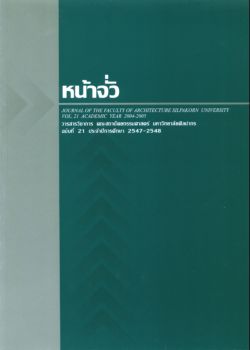วัดพู : มรดกโลกทางภูมิทัศน์วัฒนธรรมแห่งเมืองจำปาสัก
คำสำคัญ:
มรดกโลก, ภูมิทัศน์วัฒนธรรม, ปราสาทวัดพู, World heritage, Cultural landscape, Wat Puบทคัดย่อ
“วัดพู” เป็นศาสนสถานที่แสดงถึงความรุ่งเรืองของอารยธรรมบนที่ราบลุ่มริมน้ําโขงในเขตจําปาสัก และถือเป็นรากฐานสําคัญที่แสดงให้เห็นการก่อร่างสร้างตัวมีพัฒนาการทางสังคมวัฒนธรรม และรูปแบบศิลปกรรมที่เป็นเอกลักษณ์ แห่งภูมิภาคเอเชียตะวันออกเฉียงใต้ จากสังคมบุพกาลที่ดําเนินชีวิตอย่างเรียบง่ายสู่สังคมแห่งอารยธรรมที่มีโครงสร้าง สลับซับซ้อนในระหว่างพุทธศตวรรษที่ 5-18
นักวางผังในสมัยโบราณได้ปรับใช้ลักษณะทางกายภาพของพื้นที่ ให้ตอบสนองต่อแนวความคิดทางศาสนา และความเชื่อในลัทธิไศวนิกายในศาสนาฮินดู นอกจากนี้ยังปรากฏร่องรอยของแหล่งโบราณคดีจํานวนมากกระจายตัวอยู่ในพื้นที่มานับพันปี แสดงให้เห็นถึงองค์ประกอบของโครงสร้างสังคม, วัฒนธรรม, วิถีชีวิต, เศรษฐกิจ การปกครองและการศาสนาของบรรพบุรุษ และต้นธารวัฒนธรรมแห่งเอเชียตะวันออดเฉียงใต้ การนี้ศูนย์มรดกโลกองค์การยูเนสโกจึงได้ประกาศรับรองว่าพื้นที่มรดกทางภูมิทัศน์วัฒนธรรมจำปาสักเป็นมรดกทางภูมิทัศน์วัฒนธรรม (World Heritage Cultural Landscape) เมื่อปี พ.ศ. 2544
คุณค่าดังที่กล่าวมาข้างต้นทําให้เกิดแนวความคิดในการจัดการและการอนุรักษ์มรดกทางภูมิทัศน์วัฒนธรรมของพื้นที่ โดยหัวใจหลักของการจัดการต้องคํานึงถึงความยั่งยืนของภูมิทัศน์ และการดําเนินต่อไปของประโยชน์ใช้สอยในปัจจุบันของชุมชนเจ้าของพื้นที่อย่างมีอิสระในการดําเนินชีวิต มีการพัฒนาเพื่อยกระดับคุณค่า และความมั่นคงแห่งชีวิต ด้วยการอยู่ร่วมกับสภาพแวดลัอมทางธรรมชาติและวัฒนธรรมของตนอย่างยังยืน การจัดการและการพัฒนาที่ปราศจากการมีส่วนร่วมของชุมชนมิอาจเป็นการพัฒนาที่ยังยืนได้ รวมไปถึงการท่องเที่ยวที่ปราศจากการจัดการที่ดีและละเอียดลึกซึ้งเพียงพอจะกลายเป็นสิ่งที่ก่อให้เกิดผลกระทบต่อภูมิทัศน์วัฒนธรรมและมรดกทางวัฒนธรรมรวมไปถึงการสร้างความอ่อนแอให้กับชุมชนในระยะยาวด้วย
Wat Pu: The World Heritage Cultural Landscape of Champasak
“Wat pu" is a religious monument that reflects the prosperity of a civilization in the Mekong basin area of Champasak district. It is considered to be an important root of sociocultural development, from a simple ancient community to a complex civilization in the 5" - 18" century Buddhist era. It also boasts its own art style unique to the Southeast Asian region.
Town planners in ancient times adapted the physical characteristics of the site to serve religious beliefs, especially Hinduism. Traces of archeological ruins dating back thousands of years ago have been discovered scattered around the area revealing evidence of lifestyle, social, cultural, economics, political and religious structure, as well as the roots of Southeast Asian culture. Therefore, the World Heritage Center of UNESCO has declared this cultural landscape heritage of Champasak as the World Heritage Cultural Landscape in year 2001.
Such significance has led to the interest in managing and conserving this cultural landscape heritage which takes into consideration the sustainability of the landscape and the continued freedom in land use for the local community. Development should be undertaken to better the quality and security in the way of life, whereby the community can exist in harmony with their own natural and cultural environment. Management and development without the community involvement does not lead to sustainable development, and tourism without proper management will affect the cultural landscape, the cultural heritage, and eventually lead to a weak community in the long run.





